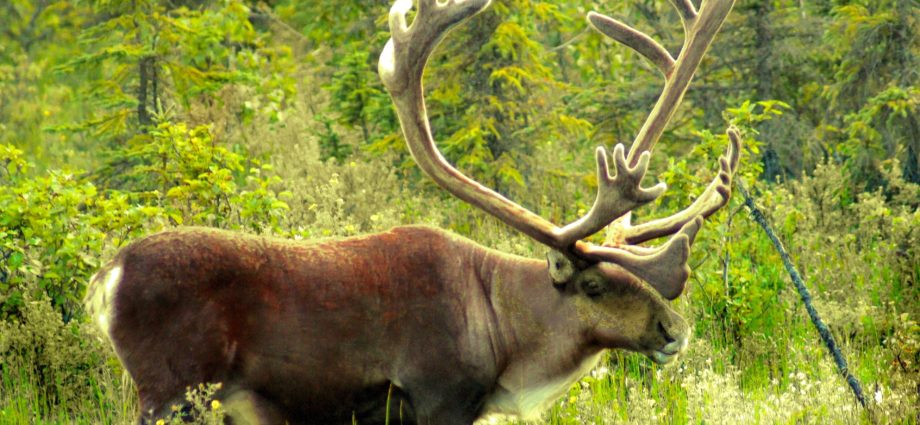
Maria Cavedon, University of Calgary and Marco Musiani, University of Calgary
March 20, 2022
When talking about caribou, most people probably think of some version of Santa Claus’s reindeer. Although real-life reindeer sadly do not exhibit any of the fantastical traits associated with helping Santa deliver gifts all over the world, caribou — their North American counterpart of the same species (Rangifer tarandus) — are in fact known to perform epic long-distance migrations.
Despite this, not everyone knows that not all caribou migrate — caribou that live in boreal forests are indeed mainly sedentary. Things can get even trickier when we consider populations in which only some caribou migrate, a phenomenon called partial migration.
Why these behavioral differences exist is a fascinating research question, the answer to which is strategically important for the conservation of migratory animals, which are globally imperiled.
In a recently published study, we examined these two types of behaviors in western Canadian endangered caribou and linked a caribou’s tendency to migrate with its genetic heritage.

Genetic markers
The main purpose of our study was to investigate whether caribou migratory behaviour is associated with genetics. To do this, we examined single nucleotide polymorphisms (SNPs), which are fragments of DNA increasingly used by researchers in genetic studies. SNPs are highly abundant and found in genes all across an organism’s entire genetic makeup. This means that they are particularly suitable for studies aimed at determining the association between genetic, ecological and behavioural characteristics.
At first, these kinds of markers were used only for model species such as humans and mice, but thanks to recent technologies, they can now be obtained and analyzed in the context of wild species at a reasonable cost.
Our research group, based at the University of Calgary, studied migratory behaviour in 139 radio-collared caribou across western Canada. These caribou belonged to populations located in different environments, ranging from tundra to forests and mountains. We examined GPS locations for each animal using several approaches, including looking at an individual animal’s movement and seasonal ranges (the winter and summer areas where the animals live).
As a result, we were able to tell which animals were migratory and which were not, and determined that caribou in the tundra tend to be more migratory than others, performing the longest migration (up to 500 kilometres one way). These findings also supported previous studies.
Genetic legacy
Our first step was to examine SNPs and determine groups of individuals with similar genetic characteristics. For each of the 139 caribou we tracked, we obtained around 30,000 SNPs. Our caribou mainly belonged to either a northern or southern group, which is consistent with previous studies.
Historically, two caribou genetic lineages evolved in separated glacial refugia (areas without ice, where flora and fauna survived) located north and south of the ice sheet during the ice ages. The historical northern refugia was predominantly composed of tundra habitat, where caribou migrated to follow seasonally available food.
In contrast, the southern portion of the species’ range was dominated by forested environments, where caribou were sedentary as a consequence of reduced seasonality of resources. Our findings showed that that caribou belonging to the northern group were more likely to migrate, indicating that migration may be associated with the genetic ancestry of caribou.

We then wanted to know whether there were specific genetic mutations associated with migratory behaviour, and consequently identified 57 SNPs associated with migration. Many of these SNPs were found in genes that may influence migration in other species. These genes included those regulating including circadian rhythms, sleep, fat metabolism and hormone production.
Overall, our findings provide initial evidence of a package of ancestral genes common across migratory groups that affects the inclination to migrate.
Humans affecting habitats
Migratory animals are known to positively affect biodiversity and ecosystem functioning. Upon arrival at a destination site, migrants deposit nutrients and other substances into resident communities and ecosystems. This is being affected by human activities, and there have been resultant dramatic declines in the populations of migratory ungulates. The disappearance of migratory behaviour is now recognized as a global conservation challenge, with alarming new findings for threatened caribou in particular.
Human-caused habitat alterations and climate change have both contributed to caribou decline. This, alongside the local extinction of some populations of mountain caribou, could mean the disappearance of other ecological and genetic behaviours.
If, as we report, migratory behaviour is genetically influenced, caribou could be further impacted by the permanent loss of migratory behaviour. Migratory behaviour, as well as the set of mutations contributing to it, may not be easily re-established once lost.
Genetic mutations, especially those that are beneficial, occur in evolutionary timeframes that are incompatible with the fast decline of caribou. In the face of rapid declines, novel mutations, including those influencing migration, are unlikely to emerge.
Sign Up for Our Newsletter.
This loss could perhaps be averted with the maintenance of seasonal habitats for caribou — a strategy that would facilitate migration and give caribou a better fighting chance at population persistence.
Maria Cavedon, Postdoctoral fellow, Wildlife Ecology, University of Calgary and Marco Musiani, Professor, Ecology and Evolution, University of Calgary
This article is republished from The Conversation under a Creative Commons license. Read the original article.


